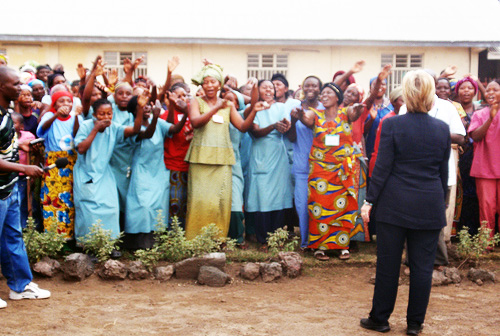
In honor of International Women’s Day it is important to take stock of the national and international mechanisms in support of gendered equality and women’s rights. The U.S. National Security Strategy notes that countries are more peaceful and prosperous when women are accorded full and equal rights, and therefore it is in our national interest to support and empower women throughout the world.
To this end, the Obama administration recently adopted the first U.S. National Action Plan on Women, Peace, and Security, officially integrating gender issues across government initiatives.
Through an executive order issued by President Obama in December 2011, the U.S. became the 34th country to adopt a National Action Plan for Women, Peace, and Security. The plan’s primary goal is “to empower half the world’s population as equal partners in preventing conflict and building peace in countries threatened and affected by war, violence, and insecurity,” which will be achieved through specific actions outlined in the plan that are to be executed by different government agencies and branches such as USAID, Department of State, and the Department of Defense. These actions range from enhancing staff capacity for applying a gender-sensitive approach to diplomacy, development, and defense in conflict-affected areas, to providing support for advocacy campaigns and programs designed to reduce family and community level violence.
The U.S. plan is the culmination of a process that began in 2000 with the U.N. Security Council’s landmark Resolution 1325 that formally recognized the impact that women play in the role of international peace and security. It emphasizes the importance of female participation in peace processes and post-conflict reconstruction, as well as the need for protection of girls and women during conflict and post-conflict settings. Now, 12 years and more than 100 translations later, the international principles outlined in Resolution 1325 are being officially upheld in the new U.S. plan.
At an event marking the release of the national action plan in December, Secretary of State Hillary Clinton said:
Whether it’s ending conflict, managing a transition, or rebuilding a country, the world cannot afford to continue ignoring half the population. Not only can we do better; we have to do better, and now we have a path forward as to how we will do better.
The U.S. action plan was drafted throughout the course of a year with the buy-in and collaboration of various U.S. government branches and agencies. It is built around a framework that addresses five key objectives: national integration and institutionalization, participation in peace processes and decision making, protection from violence, conflict prevention, and access to relief and recovery.
On paper, the plan spotlights all the right issues, but the real challenge, as U.S. Ambassador-at-Large for Global Women’s Issues Melanne Verveer pointed out, will be in the months and years ahead to ensure its implementation.
For women on the ground, including Busseina, Denise, and Zainab who were profiled this week by the Enough Project in honor of International Women’s Day, this plan and other similar national action plans have the potential to bring the ideals of gender equality and inclusion of resolution 1325 to life. The U.S. plan will support and expand on existing U.S. efforts in countries around the world. For example, in the Democratic Republic of the Congo the U.S. has provided legal advice and treatment services for more than 100,000 survivors of sexual violence in the form of mobile clinics and educational programs. And in Darfuri refugee camps in eastern Chad the U.S. is ensuring that secondary education programs are accessible to both girls and boys.
The U.S. plan will complement the 33 other national action plans already in existence.
At a recent Washington, D.C., event, Dutch Ambassador Renée Jones-Bos, whose country adopted its first action plan in 2007, offered some best practices, stressing that women must be incorporated in the action plan from the beginning and not as an afterthought. “If people are going to be effective they have to intrinsically believe [gender equality and inclusion] is important,” she said.
After reviewing its first action plan, the Netherlands decided it was stretched too thin and decided to narrow its focus in the second plan. The Netherlands second action plan thematically focuses efforts on women’s political participation and geographically focuses on Afghanistan, Democratic Republic of Congo, Burundi, Sudan, and Columbia. Ambassador Jones-Bos said that any change on the ground must begin with the realization of women’s rights as human rights. To instill this notion in Burundi and Congo, the Netherlands has interconnected the issue of sexual and gender based violence with security sector reform by establishing mobile cinemas for soldiers to view the “Weapon of War” documentary.
Even these simple actions are important for starting dialogues and building momentum to eventually bring about meaningful change. After 12 years the U.S. has finally integrated the principles laid out in Resolution 1325 across its agencies and into its initiatives throughout the world. In 2015 the U.S. will review and update its plan with consultation from international partners and relevant civil society organizations. In the next three years, much can and should be done to implement the specified actions called for in the plan and encourage the principles and norms established in Resolution 1325 to take hold once and for all.

